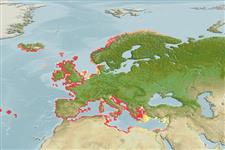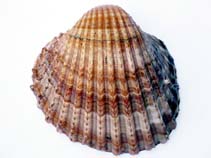Acanthocardia aculeata (Linnaeus, 1758)
Spiny cockle| Native range | All suitable habitat | Point map | Year 2050 |

|
| This map was computer-generated and has not yet been reviewed. |
| Acanthocardia aculeata AquaMaps Data sources: GBIF OBIS |
رده بندی / Names اسامي عام | مترادف | CoL | ITIS | WoRMS
Bivalvia | Cardiida | Cardiidae
Environment: milieu / climate zone / تغييرات عمق / distribution range بوم شناسي
; تغييرات عمق 5 - 30 m (مرجع 2758). Temperate; 54°N - 30°N, 11°W - 36°E
Distribution كشورها | مناطق سازمان خوار و بار جهاني (FAO) | Ecosystems | ظهور | معرفي
Northeast Atlantic and the Mediterranean: from Celtic and Lusitanian provinces, extending into the Mediterranean.
Length at first maturity / Size / Weight / سن
بلوغ: Lm ? range ? - ? cm Max length : 10.2 cm SHL جنس نر / بدون خواص جنسي; (مرجع 360); common length : 7.6 cm SHL جنس نر / بدون خواص جنسي; (مرجع 360)
توصيف مختصر ريخت شناسي
Life cycle and mating behavior بلوغ | تولید مثل | تخم ریزی | Eggs | Fecundity | Larvae
مآخذ اصلی
مراجع | هماهنگ كننده | همكاران
Gaspar, M.B., M.N. Santos and P. Vasconcelos 2001 Weight-length relationships of 25 bivalve species (Mollusca: Bivalvia) from the Algarve coast (southern Portugal). J. Mar. Biol. Ass. U.K. 81:805-807. (مرجع 2758)
وضعيت در فهرست قرمز IUCN
(مرجع 130435: Version 2025-1)
وضعيت از نظر سايتس (مرجع 108899)
CMS (مرجع 116361)
خطر برای انسان ها
استفاده انسانی
ماهي گيري – شيلات: تجاري
| FishSource |
ابزارها
اطلاعات بيشتر
تركيب غذايي
مصرف غذايي
شکارچیان
منابع اينترنتي
BHL | BOLD Systems | CISTI | DiscoverLife | FAO(Publication : search) | Fishipedia | GenBank (ژنوم, نوکلئوتيد) | GloBI | Gomexsi | Google Books | Google Scholar | Google | PubMed | Tree of Life | Wikipedia (برو, جستجو) | Zoological Record



